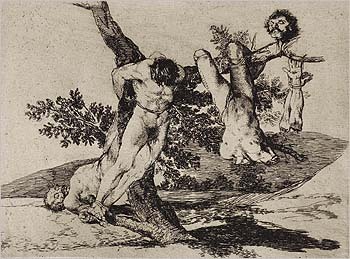Seventeen hundred years ago, Felix of Aptunga took part in the consecration ceremonies for the new bishop of Carthage. Then as now, high office came with low intrigue, and a cabal of bishops declared the consecration void, asserting that Felix had collaborated with the Romans by surrendering Bibles to officers of the persecution: no sacrament, they said, received from the hands of a sinful priest is valid.
They were overruled, ultimately by Emperor Constantine himself, but the Donatist heresy, as it came to be known, persisted for a hundred years and beyond in north Africa.
And it survives today, though now it rears its ugly head less in matters of religion than in questions of aesthetics.

I believe a number of things about Todd R. Forsgren’s photographs of birds in mist nets.
I believe that they are beautiful. I believe that they are startling. I believe that they are art.
What I do not believe is that no birds were harmed for the sake of these images. The artist says that he “basically give[s] [himself] ten minutes or so to set up and take the photographs,” a very long time indeed for a bird to hang in a net while huge bipedal predators fuss with machines. Tongues are wrenched, eyes scratched, hands and feet broken, heart rates raised: to be sure, such violent events are infrequent (probably not as infrequent as some studies suggest), but anyone with open eyes who has spent time around bird banders has seen these things and more.
No way is the oropendola in the photograph above lying quiet and passive in the pocket; that bird is struggling, and it has used its ten minutes to full advantage, working its head and its left wing entirely through the net. It also seems to have hooked a loop around its tongue. With a little patience, an experienced net-runner will have had no trouble extricating this bird from its tangle–but still, it would have been a lot easier ten minutes earlier.
But here’s the real question, the important question: does it matter? Does the fact that these photographs memorialize a situation that I think we can all stipulate is a bad one diminish their value as art? Are they, as a very thoughtful colleague of mine wrote, “ethically tainted”? Are we aesthetic Donatists, or are we willing to accept that good art can be about bad things?
In September 2001, Karlheinz Stockhausen held a press conference in Hamburg. A leading light of the German avant garde in the ’60s and 70s, Stockhausen had slipped into obscurity –but he burst forth again, and how, in Hambug with a dozen words that will live on long after his music is barely a footnote in Grove: the fall of the World Trade Center earlier that month was “das größte Kunstwerk, das es überhaupt gibt für den ganzen Kosmos,” the greatest work of art there can ever be in the entire cosmos.
The revulsion and the horror at Stockhausen’s words, just days after the attacks on New York and Washington, were universal and proper. (The universal attention paid those words was not, however, proper, given that the composer’s progress into mental illness was already well known.) As Anthony Tommasini put it in the Times, “real suffering is not [art]” and never can be.
The murder of thousands of people is not art. War is not art. And–just to ratchet things back down to our original, much more comfortable problem–trapping wild animals, for whatever purpose, is not art. To be sure, bird banding in the hands of far too many of its practitioners has become a performance and an entertainment and a money-maker, but it’s not art.
Suffering, especially suffering inflicted on unwilling and unknowing victims, is not art. But suffering is supremely and indisputably an appropriate subject for art. From venatorial scenes on the walls of Lascaux to the Grand Guignol, from medieval Passion cycles to Picasso, representations of real suffering problematize nature and human nature (and, often enough, the intersection between the two), upsetting our views of what is inevitable and what is right; and many such works do that in ways that are pretty, or striking, or clever, or even very beautiful.

Only a new Stockhausen, and one in a particularly impious frame of mind, could call the Bourbon Restoration and the occupation of Spain a work of art. But in the hands of a genius, torture, murder, and dismemberment become the stuff of masterpieces. The Disasters of War is beautiful–even if the disasters of war are not. Goya’s prints transform horror into works of formal perfection and intellectual challenge.

Todd Forsgren’s photographs are of birds captured, he tells us, by ornithologists for scientific purposes. They are suffering, but the photographer did not engineer their suffering (and I’m not sure it would make a difference to me if he had). The images he makes are not (as all those facebook photos of birds in the hand most decidedly are) souvenirs of curiosity, but rather the questioning record of a particular species of human intervention in nature. These photographs ask questions about the relationship between knowledge and freedom, science and reality, creation and “data.”
And they’re beautiful, in the way that carefully imagined depictions of shocking violence can be.
One of my friends, thoughtful and sophisticated, wrote:
I don’t like the imagery – takes away from the beauty of the birds…. seeing them all tied up like that is depressing and sad, it agitates me.
But that’s what art does. It agitates you, it “kicks complacency in the” rear, as another friend said, and makes you ask why an image or a text or a piece of music troubles or delights, or better, troubles and delights. Good art–and this is good art–takes you out of your settled ways and changes you. Good art is sacramental, and the value of a sacrament does not depend on how it is administered. We’ve known that since Carthage.

